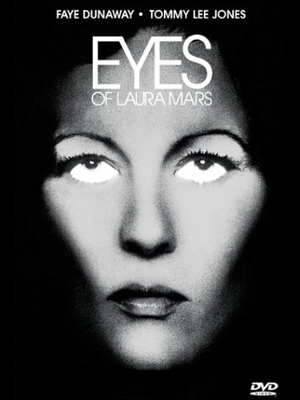
EYES OF LAURA MARS
US, 1978, 103 minutes, Colour.
Faye Dunaway, Tommy Lee Jones, Brad Dourif, Rene Auberjonois.
Directed by Irvin Kershner.
Despite the bizarre world of New York chic (Laura Mars is a fashionable gallery-published photographer of kinky scenes to make people look at contemporary violence) this is a very old-fashioned type of murder mystery, the psychic heroine who 'sees' the killings, suspense, terrorising - plus a final twist (although it's not hard to guess who's killing off the people associated with the photography). Faye Dunaway coasts through the role of Laura and Tommy Lee Jones is once again stolid as an unlikely policeman. Besides the psychic and police violence, the screenplay, based on original by John Carpenter, suggests some ideas on graphic portrayals of sex and violence but opts for romance and suspense.
l. The appeal of a murder mystery? The puzzle, clues, victims, identification, audience involvement in searching out the solution?
2. The appeal of murder mysteries in the 70s? The old-fashioned elements of the murder mystery genre, styles? Updating? The introduction to the world of the chic? American? The introduction of psychic elements and their appeal? How well did the film blend these ingredients for audience involvement and satisfaction?
3. The emphasis of the title on eyes? Laura Mars as a seer? That no explanation was given for her psychic experiences? The visualising of what she saw in terms of the actual murders? The irony of her seeing violence and the police having similar photos? What was the explanation? What could she see on the surface, beneath the surface, at a distance? Could she see the meaning of the violence? The blending of the psychic and the insight into society? Laura Mars as a photographer and seeing things with a photographer's eye - the nature of photographs as capturing reality, as contrived, as moments captured forever, as art? what Laura Mars saw in society and its violence and decadence?
4. Audience response to Laura as the heroine? Faye Dunaway's style? The introduction to her via the book, the nightmare, the violence and the photographs? The introduction to her psyche? The effect of audience identification with her? Her work, her skill and seeing her at work? The exhibition and her being feted? Her wealth, fashions? Her marriage and its break-up? Her friends, the milieu in which she lived and worked? Her having to defend her art? The experience of John's protection, love? The bonds of love, the friendship with her particular circle? Her grief at their deaths, her experience of powerlessness? The climax and the violence done to her, the disappointment, disillusionment? Would she question her art? Was she free?
5. The visual presentation of the world of chic? The photos and their content, clothing, nakedness, look, style? Their purpose as art? Advertising? For fashionable buyers? To make people look? Defective prurience, curiosity, disgust? Deeper psychic effect, especially on John Neville and on Tommy?
6. The effect of the art - on Tommy and his collection, his fascination with the models, antagonism towards Donald, devotion to Laura? His pursuing the model? His room, His death? The nature of his madness and its being taken up by John? The effect of the work on John - as a police officer and his noting the similarities of actual murders, his reactions at the exhibition and his first discussion with Laura, did he change as he got to know her and appreciate her, his protection and love of her, yet the split personality and one person talking about the other? His long explanation of his background, especially the death of his mother and his being neglected? The effect of the art on him as part of his experience? His wanting to die and yet love?
7. The portrait of John as a person, a convincing policeman, his skill at his work, relationship with the other policemen, typical? His growing love for Laura and their affair? His tenderness towards her? The irony of this for the final confrontation and his death? The irony of his giving the gun to her to kill the murderer as he approached?
8. The portrait of the New York police, interrogation, language, discussions, brutality, especially Tommy's shooting?
9. Laura's circle of friends and their personalities, quirks? Tommy and his background, his appearance, his work, suspicions? Doris and the initial murder? The fashionable owner of the gallery and her liaison with Michael and her death? Donald as a type, his manner, his skill, work as an agent, his birthday party, his helping Laura get away in disguise, the ugliness of his death?
10. The personalities of the models, their work, the background to their dressing, make-up, acting? Their fame? The ugliness of their deaths?
11. The film styles used to convey the manner of the sessions, the poses and the music, the violent tableaux? The finished product at the exhibition, the advertisements? The actual murders visualised as art?
12. The chic world and its tensions? Laura's studio, home, the ugly warehouse look and the harbour, the fashionable interiors? Laura running, car chases? The chase in the streets? Michael and his fear? A credible world in a world of fashion?
13. How well did the film blend the techniques of the murder mystery with its contemporary themes?